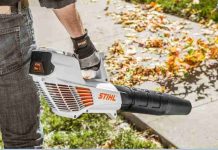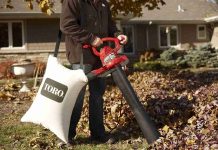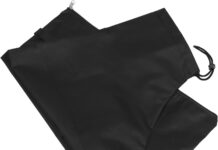When it comes to choosing the perfect leaf blower, it can be overwhelming with all the technical jargon and specifications.
However, two key factors play a vital role in determining the efficiency and effectiveness of a leaf blower: CFM and mph. CFM stands for cubic feet per minute and measures the volume of air that the blower can move in one minute.
On the other hand, mph refers to miles per hour and indicates the speed at which the air is expelled from the device. In this article, we will explore the importance of CFM and mph and uncover which factor holds more significance in getting the job done swiftly and seamlessly.
Importance of CFM and MPH in Leaf Blowers
Leaf blowers are essential tools for maintaining clean and tidy outdoor spaces. Whether tackling a small residential yard or a large commercial area, having the right leaf blower can make a difference in effectiveness and efficiency. When choosing a leaf blower, two critical factors to consider are CFM (cubic feet per minute) and MPH (miles per hour) – both of which play a crucial role in the blower’s performance. Let’s dive deeper into understanding CFM and MPH and their importance in leaf blowers.
Understanding CFM and MPH
Before exploring the significance of CFM and MPH, let’s first understand what each represents. CFM measures the air volume the leaf blower can move in a minute. It indicates the blower’s air volume output, or in other words, the amount of air that is pushed out by the blower. On the other hand, MPH refers to the speed at which the air leaves the blower’s nozzle in miles per hour. It measures the blower’s air velocity or the force at which the air is expelled.
Balancing Air Volume and Air Speed
Regarding leaf blowers, it is not just about having high CFM or MPH individually but about finding the right balance between them. An ideal leaf blower should have a high CFM and MPH to ensure effective performance. While CFM determines the blower’s ability to move a large amount of debris, MPH assists in blowing away heavier or wetter materials. Combining air volume and air velocity creates a powerful force that can efficiently move leaves, dirt, grass clippings, and other debris.
Factors Affecting CFM and MPH
Several factors can affect the CFM and MPH of a leaf blower. One significant factor is the blower’s design, precisely its fan size, housing, and motor power. A leaf blower with a larger fan and motor generally has a higher CFM and MPH. Additionally, the blower’s nozzle design and the presence of any attachments or accessories can influence its performance. A nozzle that is too narrow can restrict the airflow, reducing both CFM and MPH. Considering these factors when selecting a leaf blower is essential, as they can significantly impact its effectiveness.
Choosing the Right CFM and MPH
When choosing a leaf blower, assessing your specific needs and the characteristics of your outdoor space is vital. A leaf blower with a higher CFM and MPH would be more suitable if you have a large yard or frequently deal with heavy debris. Conversely, lower CFM and MPH may be sufficient for smaller spaces or less demanding tasks. Sticking the right balance is essential to ensure optimal performance without compromising efficiency.
Practical Considerations for CFM and MPH
Apart from considering the ideal CFM and MPH, there are several practical aspects to consider when selecting a leaf blower. These factors can contribute to the overall user experience and the blower’s efficiency in different environments.
CFM (Cubic Feet Per Minute)
Definition and Calculation of CFM
CFM, or Cubic Feet Per Minute, is a unit of measurement that quantifies the volume of air moved by a leaf blower in one minute. It indicates the blower’s air output capacity and is calculated by multiplying the airspeed (in feet per minute) by the size of the blower’s nozzle opening (in square feet).
Role of CFM in Leaf Blowers
CFM is critical in determining a leaf blower’s overall performance, especially when dealing with lightweight debris such as leaves, grass clippings, or dry dirt. A higher CFM means the blower can move a larger air volume, allowing it to cover a broader area and clear away debris more effectively. It provides the necessary push to move lightweight materials over long distances and can help save time and effort when tackling large outdoor spaces.
Benefits of Higher CFM
Opting for a leaf blower with a higher CFM offers several advantages. Firstly, it enables faster and more efficient clearing of leaves and debris, reducing the time required to complete the task. Secondly, higher CFM helps cover a larger area with a broader air spread, resulting in quicker cleanup. Lastly, it ensures better control over lightweight materials and prevents them from getting stuck or blowing back into already cleared areas.
Limitations of Higher CFM
While higher CFM can be advantageous in many cases, it may not always be ideal. A blower with a high CFM may produce too much air volume, which can potentially cause damage to delicate surfaces and plants or even blow loose topsoil away. It’s essential to consider the specific needs of your outdoor space and strike a balance between CFM and other factors to avoid unintended consequences.
MPH (Miles Per Hour)
Definition and Calculation of MPH
MPH, or Miles Per Hour, measures the speed at which the air leaves the blower’s nozzle. It quantifies the blower’s air velocity or the force at which the air is expelled. It is calculated by dividing the air distance (in miles) by the time it takes for the air to travel that distance (in hours).
Role of MPH in Leaf Blowers
MPH is crucial in handling heavier or wetter materials that require more force to clear effectively. It determines the blower’s ability to dislodge stubborn debris, such as wet leaves or clumps of dirt. Additionally, higher MPH allows the blower to blow away debris from more considerable distances.
Benefits of Higher MPH
Investing in a leaf blower with a higher MPH offers several benefits. Firstly, it increases the blower’s ability to tackle heavier debris, making it more effective in demanding cleaning tasks. Secondly, a higher MPH ensures better control over materials that may resist movement, enabling faster clearing. Lastly, it allows the blower to reach debris situated farther away, reducing the need for manual raking or cumbersome additional tools.
Limitations of Higher MPH
While a higher MPH is essential for handling heavier debris, it may not be the sole determining factor in all situations. Very high MPH without sufficient CFM may result in limited coverage area or ineffective clearing of lighter debris. Balancing MPH with CFM is necessary to ensure optimal performance without compromising efficiency.
Comparing CFM and MPH
Importance of Balancing CFM and MPH
Finding the right balance between CFM and MPH is crucial to achieving the best performance from a leaf blower. A high CFM ensures coverage of a larger area and efficient clearing of lightweight materials, while a high MPH provides the force necessary to handle heavier or wetter debris. Balancing these two factors ensures versatility and flexibility in handling various cleaning tasks.
Relationship between CFM and MPH
CFM and MPH are interdependent factors in leaf blowers. Increasing CFM without a proportional increase in MPH may result in limited airspeed, reducing the blower’s ability to clear heavier debris effectively. Similarly, increasing MPH without sufficient CFM may result in a narrow air stream, limiting the coverage area and leaving behind unblown debris. Considering CFM and MPH together is essential to strike the right balance for optimal performance.
Considering the Task and Surface
When selecting a leaf blower, it’s vital to consider the specific cleaning tasks and surfaces you’ll be dealing with. A higher CFM may be more beneficial if you primarily need to clear a large area of leaves or grass clippings. On the other hand, if you frequently face wet or heavy debris, a higher MPH would be advantageous. You are additionally considering the type of surface – whether a flat lawn, a gravel driveway, or an uneven terrain – can influence the required CFM and MPH for effective results.
Practical Examples
To better understand the significance of CFM and MPH, let’s consider a couple of practical scenarios. For instance, if you have a small residential yard with moderate dry leaves, a leaf blower with a CFM between 300-400 and an MPH around 150-200 would be suitable. This combination offers sufficient air volume to move the leaves without excessive force that may damage delicate plants or surfaces.
However, a leaf blower with a higher CFM (500-800) and MPH (200-250) would be more appropriate if you have a larger yard with denser trees and frequently deal with heavy debris. This would provide the power to clear more significant leaves and heavier debris more efficiently.
Other Important Factors to Consider
Besides CFM and MPH, several other factors should be considered when choosing a leaf blower. These factors can significantly impact user experience, overall performance, and long-term usability.
Noise Levels
Leaf blowers can be noisy, and it’s essential to consider the noise levels while selecting one. If you live in a residential area with noise restrictions, choosing a quieter leaf blower can help maintain good relations with neighbors while still achieving effective cleaning.
Weight and Size
The weight and size of the leaf blower are crucial factors to consider, especially regarding user comfort and maneuverability. A lighter, more compact blower allows easier handling and reduces fatigue during extended cleaning sessions.
Power Source
Leaf blowers can be powered by either electricity or fuel (gasoline or battery). Each power source has its advantages and limitations. Electric blowers are generally lighter, produce less noise, and require less maintenance. However, they may be limited by a cord length or battery life. Fuel-powered blowers offer greater mobility but may be heavier, noisier, and require regular fueling and maintenance.
Build Quality and Durability
Leaf blowers are subjected to outdoor elements and demanding cleaning tasks. Choosing a blower with good build quality and durable materials ensures longevity and reliability, reducing the need for frequent replacements.
User Considerations
Apart from technical specifications and performance factors, it’s essential to consider individual user considerations when selecting a leaf blower.
Personal Strength and Physical Abilities
User strength and physical abilities play a significant role in determining the ideal leaf blower. A lightweight, easy-to-handle blower would suit individuals with less strength or mobility.
Noise Tolerance
Some users may be more sensitive to noise and prefer a quieter leaf blower, even if it means sacrificing some CFM or MPH. Considering personal noise tolerance ensures a more pleasant user experience.
Ease of Use and Maneuverability
Factors such as ergonomic design, well-placed controls, and ease of operation contribute to a leaf blower’s overall user-friendliness. Considering ease of use and maneuverability simplifies the cleaning process and makes it more enjoyable.
Budget and Value for Money
Budgetary constraints are always a factor when purchasing any equipment. Finding a leaf blower that balances performance, features, and overall value for money within the specified budget is essential.
Conclusion
In conclusion, CFM and MPH play vital roles in the performance of leaf blowers. CFM determines the blower’s ability to move a large volume of debris efficiently, while MPH provides the necessary force to handle heavier or wetter materials.
Finding the right balance between these two factors is critical to achieving optimal cleaning results. When selecting a leaf blower, it’s also important to consider other factors such as noise levels, weight, power source, and personal user considerations.
Considering all these aspects, you can make an informed choice and find the perfect leaf blower that suits your specific needs, making maintaining your outdoor space a breeze.



































